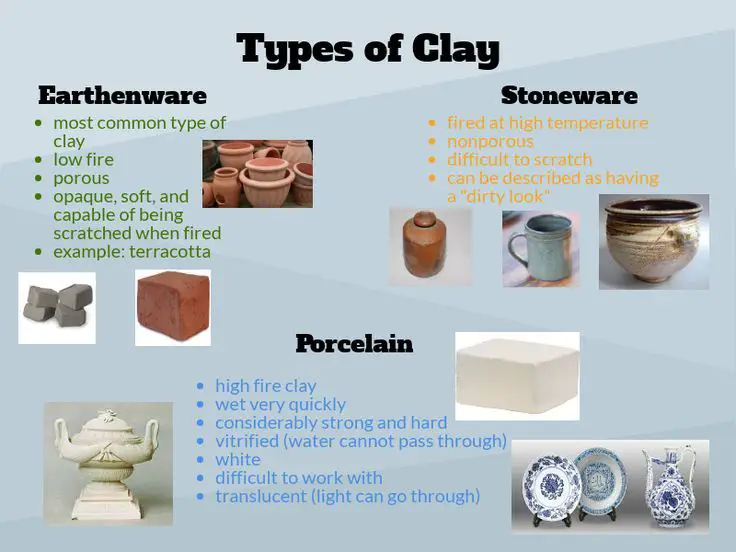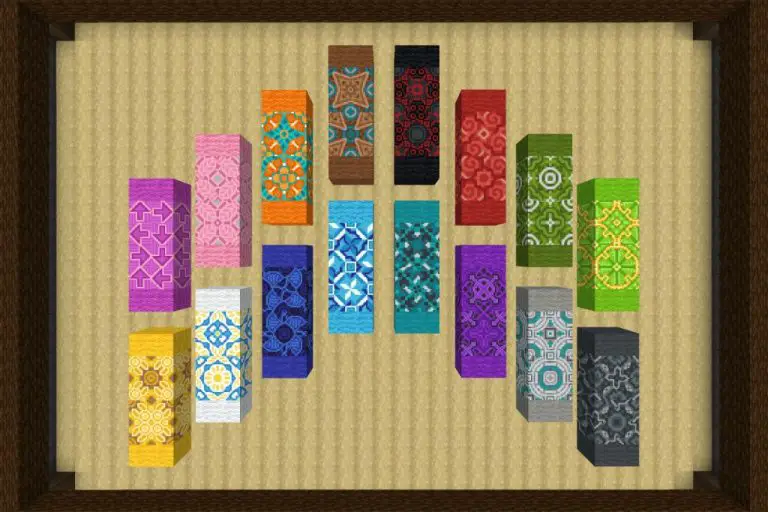Understanding Clay: A Beginner’S Introduction
What is Clay?
Clay is a fine-grained natural soil material containing clay minerals. Clays develop plasticity when wet, allowing them to be molded into shape, but harden when fired or dried in air.
Clay is composed primarily of phyllosilicate minerals, which consist of fine-grained crystals stacked in plates. The most common types of phyllosilicate minerals in clay are kaolinite, montmorillonite-smectite, illite, and chlorite.
There are four main types of clay categorized based on their mineral composition and particle size: kaolin, ball clay, stoneware clay, and earthenware clay. Kaolin clays contain a high percentage of kaolinite and are relatively pure. Ball clays have high plasticity and are often mixed with other clays. Stoneware clays are coarse, dense, and heat resistant at high temperatures. Earthenware clays are highly plastic but have lower firing temperatures.
The small particle size and platy structure allow clays to be molded when wet, absorb liquids, and develop plasticity. When fired, the plate-like clay particles bond tightly together through sintering. This makes clay a uniquely versatile material for pottery, ceramics, bricks, and other applications.
(Source: https://en.wikipedia.org/wiki/Clay)
Origins and Geology
Clay is formed from the gradual chemical weathering of rocks over long periods of time. According to the USGS, clays form under a limited range of geologic conditions typically in soil horizons near the earth’s surface (https://pubs.usgs.gov/info/clays/). The most common rocks that decompose to form clay minerals are feldspar and mica. Glendale Community College notes that the feldspar and mica in igneous rock slowly breaks down into kaolinite, montmorillonite, and illite – the three major groups of clay minerals (https://www.glendale.edu/academic-divisions/visual-performing-arts-division/ceramics/study-guides/clay-geology).
The specific geological and environmental conditions impact the type of clays formed. Clay deposits are found across the world often in sedimentary rock basins. The highest quality clay deposits formed from the weathering of granite, feldspar, and pegmatite. Common locations include the central and southeastern US, UK, central Europe, and east Asia.
Clay Properties
Some of the key properties of clay that make it useful for pottery and ceramics are its plasticity, shrinkage, porosity, and hardness. Clay is a plastic material meaning it can be molded, bent, or formed when wet without breaking or cracking. However, clay also shrinks as it dries due to the loss of water. This shrinkage allows clay to become extremely hard when fired in a kiln (USGS).
Clay is porous which allows it to soak up water and any soluble materials, giving it even more plasticity and ability to be shaped (Wikipedia). The porosity also allows clay to hold glazes and colorants. After firing, clay becomes permanently hard making it durable and water-resistant while maintaining porosity.
The combination of plasticity, shrinkage, porosity and hardness allow clay to go from a soft, shapeable material to a hardened, finished ceramic product through the process of drying and firing in a kiln.
Types of Clay
There are several different types of clay that are commonly used in pottery and ceramics. Each type of clay has its own distinct properties and characteristics.
The three main types of clay are classified according to the mineral content:

- Kaolinite – This type of clay is named after Kaolin, China where it was first discovered. Kaolinite clays are white firing and include porcelain clay bodies. They are less plastic than other clays and have lower shrinkage.[1]
- Montmorillonite – Montmorillonite clays contain variable amounts of iron and magnesium, which makes them extremely plastic and gives them high shrinkage. They are commonly used for casting and throwing on the wheel.
- Illite – An illite clay has properties in between kaolinite and montmorillonite. Illite clays can be used to make stoneware and earthenware.
Some other common types of clay include:
- Ball clay – A secondary clay with high plasticity and high firing shrinkage. It is often mixed with kaolin to make porcelain bodies.
- Stoneware clay – Fires to a strong, vitrified stone-like body at high temperatures. It has good workability.
- Earthenware clay – Lower firing clay that can be fired at lower temperatures to make terra cotta pots and figures. It fires to a porous, opaque ceramic.
- Porcelain – A white firing kaolin clay that becomes vitrified and translucent when fired at high temperatures. It is non-porous and very strong.
Choosing the right type of clay is an important first step in creating high quality pottery and ceramic work.
Working with Clay
Properly preparing clay is an important first step before beginning any handbuilding project. Here are some key techniques for working with clay:
Wedging
Wedging involves kneading the clay to remove air bubbles and evenly distribute moisture. This helps prevent cracking and breakage during drying and firing. To wedge, cut off a workable amount of clay and slam it down onto the wedging table repeatedly (Source).
Slurry, Scoring and Slipping
Slurry, scoring, and slipping helps clay pieces adhere together. To make a slurry, mix clay and water into a thick liquid consistency. Score areas to be joined by making criss-cross marks with a fork. Apply slurry or slip (liquid clay) to scored areas and press pieces together firmly (Source).
Drying
Let clay pieces air dry completely before firing. Drying time depends on factors like climate, thickness, and composition. Set pieces out of direct sunlight and moving air. Cover with plastic to slow drying if needed to prevent cracking.
Clay Bodies
A clay body refers to the mixture of different clays and additives used to achieve certain characteristics and firing behavior. Clays can be mixed together along with non-clay materials called fluxes, fillers, and stabilizers to create clay bodies with specific properties. Some key considerations when making clay bodies include plasticity, shrinkage, porosity, color, and firing temperature.
There are many recipes for mixing clay bodies, depending on the desired characteristics and type of clay work. A simple clay body can contain a single type of clay, while more complex recipes mix several types of clays and additives. Some common additives include feldspar, silica, grog, and bentonite. Grog, which is ground up fired clay, helps reduce shrinkage and cracking. Feldspar acts as a flux to vitrify the clay at high temperatures. Silica aids thermal expansion, and bentonite increases plasticity.
Here is an example of a versatile stoneware clay body suitable for throwing on the wheel at cone 10 temperatures, taken from Alfred’s Grinding Room Recipes:
25% Goldart Clay
25% CX-10 Ball Clay
20% OM4 Ball Clay
15% Silica
10% Custer Feldspar
5% Bentonite
Clay bodies can be bought premixed, but many ceramic artists enjoy experimenting with clay recipes to achieve the perfect blend of workability, color, and firing behavior for their needs. With proper understanding of clay mineralogy and how additives interact, you can learn to mix custom clay bodies tailored to your projects.
Clay Tools
Clay tools are essential for working with clay and allow potters to sculpt, shape, carve, cut, smooth, and decorate their pieces. The main types of clay tools include:
Basic Tools
Basic tools like cutting wires, ribs, and scrapers allow potters to cut slabs of clay evenly, smooth surfaces, and remove excess clay (The Ceramic Shop, n.d.). Metal loop tools help create textures and patterns. Sponges, brushes, and painting tools apply slips, underglazes, and glazes. Needle tools make holes for hanging and drying finished pieces.
Wheel Throwing Tools
Throwing tools like ribs, kidney tools, trimming tools, and loop tools assist in centering, opening, and shaping clay on the potter’s wheel (Diamond Core Tools, n.d.). Specialty tools like chucks and wires help remove finished pieces from the wheel.
Handbuilding Tools
Handbuilding requires sculpting and smoothing tools like loop tools, ribs, rasps, ribs, and wooden modeling tools. Texture mats, rollers, and stamps add details like scales, waves, bark, or other patterns (Amazon, n.d.).
With the wide variety of clay tools available, potters can find the right selection for their technique, skill level, and project needs.
Firing Clay
Firing clay is the process of heating clay wares in a kiln in order to cure the clay, harden it, and prepare it for its final use. There are several types of firings in clay work:
Bisque Firing
Bisque firing is the first firing of clay objects. This initial firing prepares the clay by removing any water, surfacing fine details, and making the clay easier to glaze by closing the pores at around cone 04. Bisque firing is done in an electric or gas kiln, heating the clay to around 1000-1100°F. The clay will turn white as it vitrifies during the bisque firing. (Source)
Glaze Firing
After bisque firing, clay objects are glazed and then fired again to melt and fuse the glaze to the clay body. Glaze firing happens at higher temperatures, usually between cone 4 and cone 10 (2,200°F – 2,400°F). The glaze chemically bonds to the clay body during this firing. (Source)
Raku Firing
Raku is a specialized technique where bisqueware pieces are fired quickly and removed from the hot kiln to allow the glazes to crackle from rapid cooling. This process results in unique iridescent finishes. Raku firings can happen in gas or wood-fueled kilns heated to 1800-1975°F.
Pit Firing
Pit firing involves placing wares in a fire pit or trench filled with combustible material like sawdust or wood. The fire is lit and burns for several hours, cooled, and then the pieces are removed. This technique results in irregular fire effects on the clay.
Kilns
Kilns are thermally insulated chambers used for firing clay or glazes. Electric and gas kilns allow precise control over firing temperatures. Wood-fired kilns impart effects from wood ash. Advanced kilns may have programmers to automatically control the firing schedule.
Glazes
Glazes are vitreous coatings applied to ceramic surfaces to provide an impervious decorative finish. The main ingredients in a glaze are silica, fluxes, and stabilizers.
Silica, usually in the form of silica sand, quartz, or flint, provides the glassy matrix of the glaze. Fluxes lower the melting temperature of the glaze so it vitrifies at workable temperatures. Common fluxes include feldspar, borax, and lead. Stabilizers help suspend the glaze ingredients evenly during firing.
To make a glaze, the dry ingredients are thoroughly mixed together according to a recipe. The glaze powder is then added to water and mixed to a smooth creamy consistency before applying to bisqueware. Glazes can be applied by dipping, pouring, spraying, or brushing.
During firing, the glaze melts and flows into an impervious glassy coating. Firing temperature affects the surface finish from glossy to satin matte. Specific glaze effects depend on the recipe and kiln temperatures. Always test new glaze recipes on test tiles before applying to finished ware. With carefully formulated recipes, beautiful glazes enhance ceramic forms with colors, textures, and effects. (Source 1, Source 2)
Clay for Beginners
Getting started with pottery and working with clay can be intimidating at first, but with some basic tips and starter projects, beginners can quickly get the hang of working with clay and making basic pottery pieces. Here are some tips for starting with clay as a beginner:
Focus on centering and opening up clay on the pottery wheel first. Master these basic skills before attempting more complex pieces. Take it slow and practice often. Refer to tutorials such as “Six Best Tips for Beginners Learning How to Wheel Throw” (https://ceramicartsnetwork.org/daily/article/six-top-tips-for-beginners-learning-how-to-wheel-throw).
Try basic handbuilding techniques like pinch pots, coils, and slabs to make simple pottery pieces without a wheel. Easy beginner projects are pinch pot bowls, coil pots, and slab-built boxes. See “Pottery Tips and Techniques for Beginners” (https://www.classpop.com/magazine/pottery-for-beginners) for handbuilding instructions.
Practice consistency in thickness and shaping. Variations can lead to cracking or exploding in the kiln. Use calipers or rulers to check thickness and size while building.
Let your pieces fully dry before firing. Moisture left in the clay can cause cracking or explosions. Allow even small pieces to dry for a few days before bisque firing.
Start with low-fire clays and glazes. They are more beginner-friendly and forgiving. Mid-range stoneware can be attempted after gaining experience.
Learn the firing schedules and clay/glaze combinations recommended by your clay and glaze manufacturers. Follow instructions carefully to avoid disappointments.
Be patient with yourself as you learn a new art form. Making mistakes is part of the process. Focus on enjoying the tactile, creative process and problem-solve as you go.
Connect with other potters, take classes, and continue learning. Feedback and community enrich the pottery journey.



